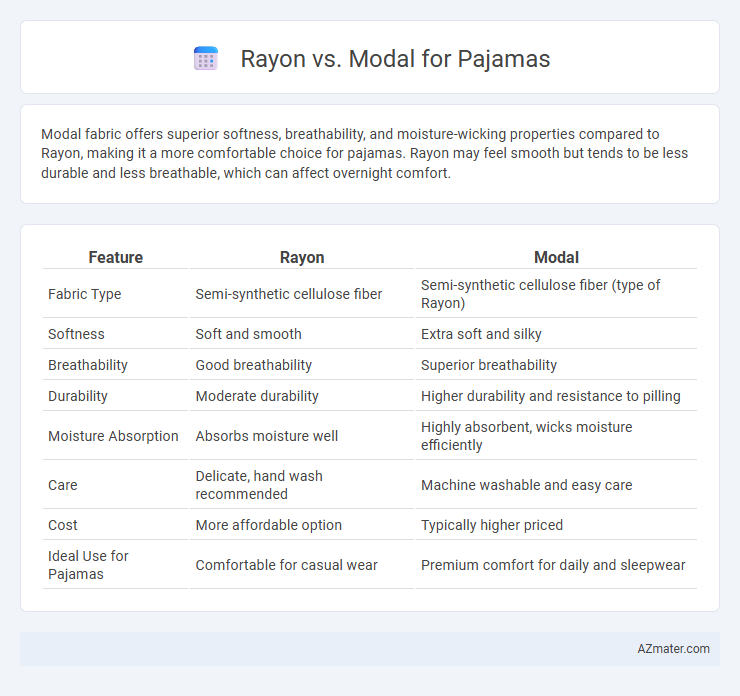Modal fabric offers superior softness, breathability, and moisture-wicking properties compared to Rayon, making it a more comfortable choice for pajamas. Rayon may feel smooth but tends to be less durable and less breathable, which can affect overnight comfort.
Table of Comparison
| Feature | Rayon | Modal |
|---|---|---|
| Fabric Type | Semi-synthetic cellulose fiber | Semi-synthetic cellulose fiber (type of Rayon) |
| Softness | Soft and smooth | Extra soft and silky |
| Breathability | Good breathability | Superior breathability |
| Durability | Moderate durability | Higher durability and resistance to pilling |
| Moisture Absorption | Absorbs moisture well | Highly absorbent, wicks moisture efficiently |
| Care | Delicate, hand wash recommended | Machine washable and easy care |
| Cost | More affordable option | Typically higher priced |
| Ideal Use for Pajamas | Comfortable for casual wear | Premium comfort for daily and sleepwear |
Introduction to Rayon and Modal Fabrics
Rayon is a semi-synthetic fiber made from regenerated cellulose, valued for its softness and breathability, making it a popular choice in pajama fabrics. Modal, a type of rayon derived specifically from beech tree pulp, offers enhanced durability and moisture-wicking properties, providing superior comfort for sleepwear. Both fibers blend natural cellulose characteristics with advanced processing to create lightweight, smooth textiles ideal for comfortable pajamas.
What is Rayon?
Rayon is a semi-synthetic fiber made from regenerated cellulose derived from wood pulp, offering a soft and breathable fabric ideal for pajamas. It mimics natural fibers like cotton, providing excellent moisture absorption and a smooth texture that enhances comfort during sleep. Its affordability and versatility make rayon a popular choice in sleepwear, balancing durability with luxurious softness.
What is Modal?
Modal is a type of semi-synthetic fabric made from beech tree pulp, known for its softness, breathability, and moisture-wicking properties, making it ideal for comfortable pajamas. It offers better durability and resistance to shrinkage compared to rayon while maintaining a silky smooth texture that feels gentle on the skin. Modal pajamas provide enhanced comfort due to their lightweight, hypoallergenic nature and excellent temperature regulation.
Pajama Comfort: Rayon vs Modal
Modal pajamas offer superior softness and breathability compared to rayon, making them ideal for all-night comfort. Rayon can feel smooth but tends to retain moisture, which may lead to discomfort during warm nights. Modal's moisture-wicking properties and increased durability ensure a more comfortable and long-lasting pajama experience.
Breathability and Moisture-Wicking Properties
Modal fabric offers superior breathability compared to rayon, allowing better air circulation that keeps pajamas cool and comfortable during sleep. Rayon tends to retain more moisture, while modal excels in moisture-wicking properties by efficiently drawing sweat away from the skin and drying quickly. This makes modal pajamas an ideal choice for individuals seeking enhanced comfort through effective temperature regulation and moisture management.
Durability and Longevity Comparison
Modal fabric exhibits superior durability and longevity compared to rayon when used in pajamas, thanks to its higher wet strength and resistance to pilling. Rayon tends to weaken and lose shape after multiple washes, whereas modal maintains its softness and color retention over extended use. Choosing modal pajamas results in better long-term wear and sustained fabric integrity.
Environmental Impact: Rayon vs Modal
Modal offers a more environmentally friendly alternative to rayon in pajama production due to its sustainable sourcing from beech tree pulp and a less chemically intensive manufacturing process. Rayon production often involves toxic chemicals like carbon disulfide, contributing to higher environmental pollution compared to the eco-friendlier closed-loop production system used for modal. Pajamas made from modal also tend to have a lower carbon footprint and require less water, reinforcing modal's position as a greener textile choice over conventional rayon.
Maintenance and Care Tips
Rayon pajamas require gentle hand washing or machine washing on a delicate cycle with cold water to maintain fabric quality and prevent shrinkage. Modal pajamas boast higher durability and color retention, enabling easier machine washing with similar care but drying on low heat or air drying to avoid fabric damage. Both fabrics benefit from avoiding harsh detergents and ironing on low settings to preserve softness and longevity.
Price and Affordability
Rayon pajamas are generally more affordable than modal pajamas due to lower production costs and broader material availability. Modal fabric, derived from beech tree pulp, tends to be pricier but offers superior softness and durability, making it a premium choice for sleepwear. Consumers seeking budget-friendly pajamas often prefer rayon, while those prioritizing comfort may invest more in modal options.
Which Fabric is Best for Pajamas?
Modal fabric offers superior breathability and moisture-wicking properties compared to rayon, making it ideal for comfortable and cool pajamas. Rayon, while soft and smooth, tends to retain moisture and can feel heavier, which may reduce comfort during sleep. Modal's durability and resistance to shrinkage ensure long-lasting, breathable pajamas that enhance nighttime comfort.

Infographic: Rayon vs Modal for Pajama
 azmater.com
azmater.com